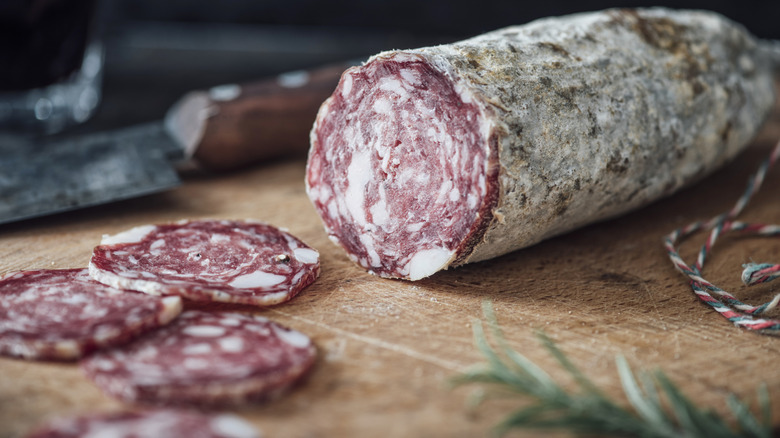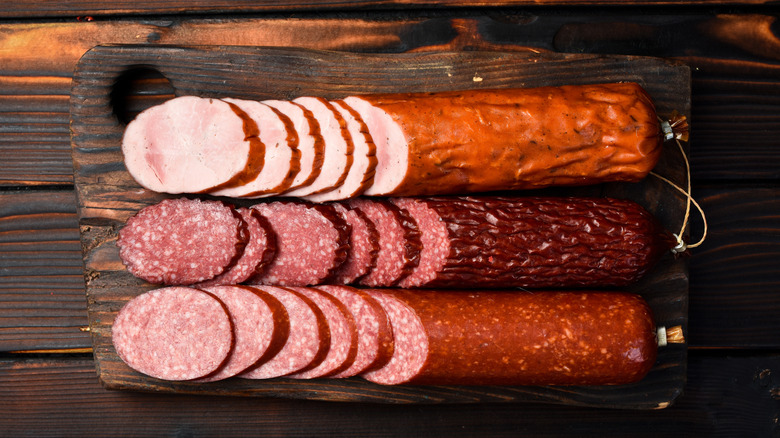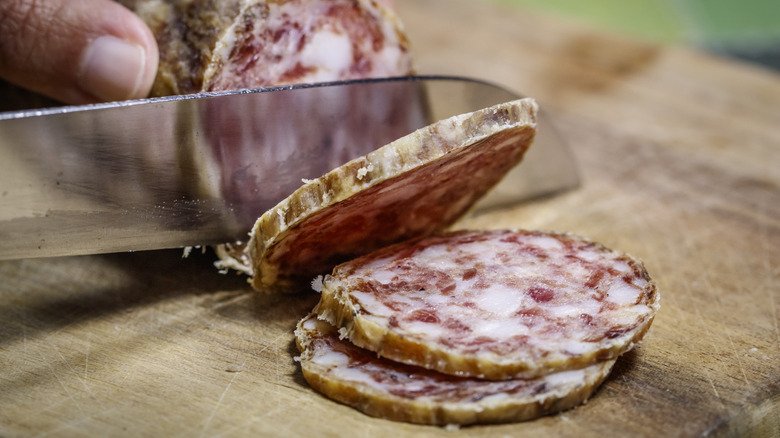The Main Differences Between Salami And Its French Cousin, Saucisson
The delights of cured meats stretch back through time. Humans have preserved proteins with salt for thousands of years. Subsequently, it's no surprise that the list of essential cured meats is extensive, with many intricacies to slice into. Cured cuts can look visually similar and be composed of the same protein base, yet nuance in processing and flavoring heavily impacts the culinary experience.
Take salami and saucisson, for example. These two cured meats emerged out of Ancient Roman preservation techniques, are often composed of red-hued pork interspersed with small fat specks, and come encased in a white and (intentionally) moldy lining. Flavor-wise, the overlap continues; the two are primarily seasoned with salt and spices. Given these factors, it's tempting to say that two are interchangeable. Salami encompasses sausages made in Europe and beyond, so why not include saucisson in the category?
Despite its commonalities with salami, saucisson has a specific role in French culinary tradition that's worth appreciating. After all, it's this kind of culture-driven diversity that makes the world of cured meats so expansive and delicious.
Salami is produced in many different ways
Name a cold cut off the top of your head, and salami will quickly come to mind. Available in several hundred styles, it's one of the most well-known and wide-ranging preserved meat products. Countries like Germany, Russia, Spain, the U.S., Hungary, and — most famously Italy — all make salami.
Not to be confused with salumi, Italian salami alone showcases an impressive range. While Florence's chunky-textured salami or southern Italy's soppressata may resemble saucisson, options like Genoese salami (which incorporates veal) and Milan's rendition featuring beef and wine diverge from tradition with components atypical in French saucisson. And though some salamis are salted, dry-cured, and fermented similarly to saucisson, others can be wet-cured, yielding a softer product like mortadella.
Other types of salami also include fatty, spicy and spreadable Calabrian 'Nduja, dry-cured and smoked Hungarian salamis, and an Austrian style that adds cheese into the mix. What's dependable is that salami comes as a preserved meat in a tubed casing. Past that, the title embraces far more products than saucisson.
French saucisson refers to a specific pork product
Like salami, French saucisson's essence lies in preservation. However, as opposed to the varying methods used for salami, saucisson specifically refers to a dry-cured meat. In fact, the foodstuff's name comes from saucisson sec, which translates to dry sausage in French. Furthermore, saucisson's dry-curing production process is more straightforward than many salami varieties. Seasoned with ample salt, saucisson's protein is mixed with various seasonings, stuffed into a casing, and dried in a cool environment. During dehydration, fermentation occurs, forming saucisson's tart flavors and unmistakable white exterior.
Saucissons often come in a lightly bent shape and are around 1.5 inches thick. Since its origin during the Roman Empire, this food has always used pork as its star protein (unlike salami, which can be composed of beef, boar, or a mixture of meats). Cut into a tasty saucisson, and you can expect a blend of both fat and meaty pork chunks.
What differentiates one saucisson producer from another is the seasonings used. While makers in Arles stick to just salt, creators along the Swiss border add hazelnuts, and South-Eastern Saucisson de L'Ardéche includes spices like cumin, ginger, cloves, and more. Across France, saucisson dependably appears on most charcuterie boards. So, order a cured cut appetizer the country, and you'll get to sample this delicious pork product. Just make sure to brush up on these French food and drink phrases before you go.



